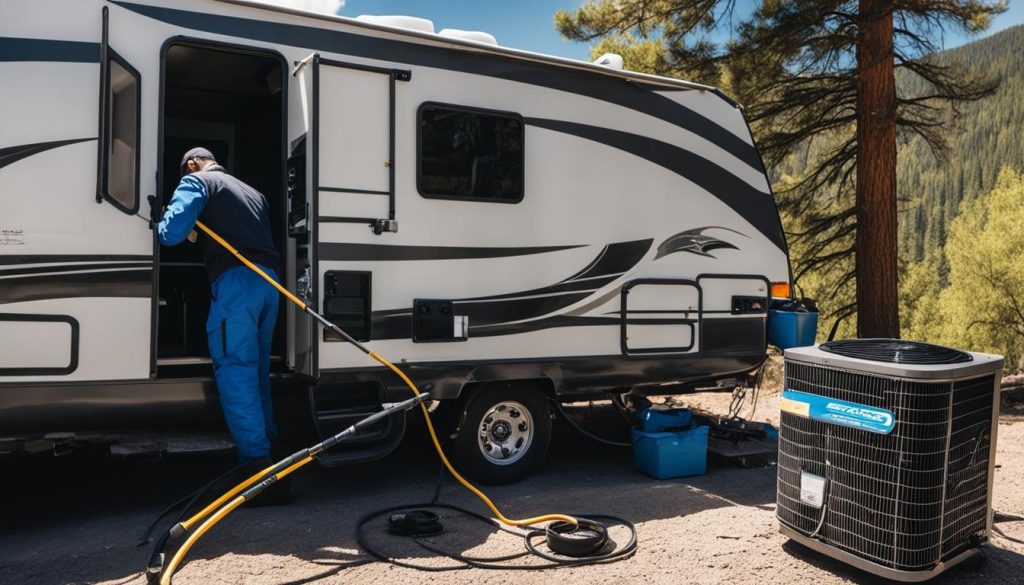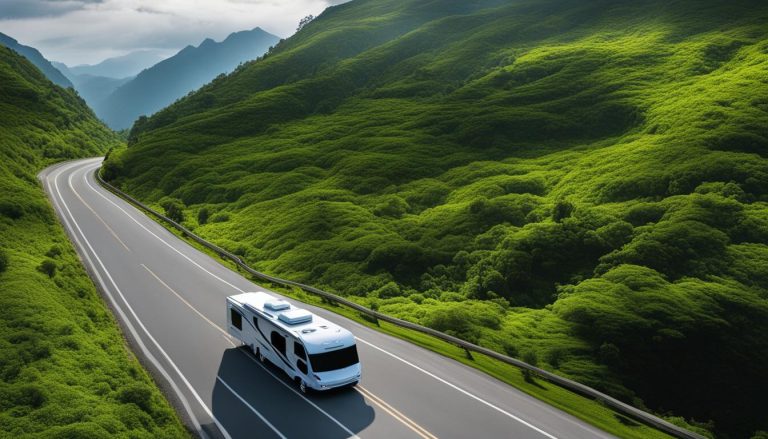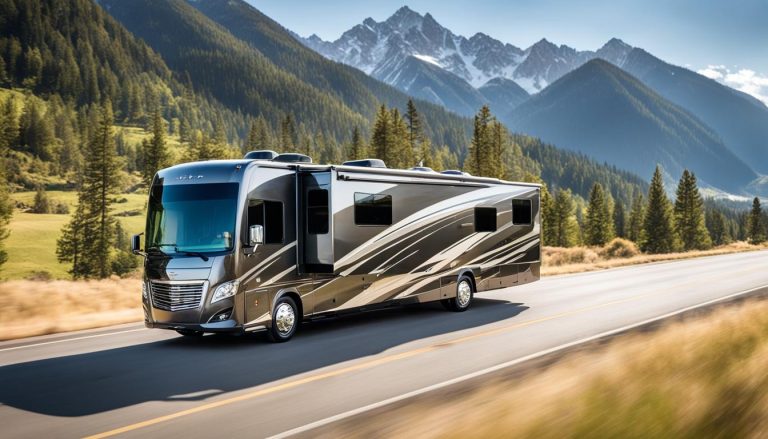RV Air Conditioner Cleaning Made Easy
gorvlifestyle.com and its partners may earn a commission if you purchase a product through one of our links
Keeping your RV air conditioner clean and well-maintained is essential for optimal performance and comfort on the road. Regular cleaning and maintenance can prolong the life of your RV AC unit and prevent issues down the line. In this article, we will provide you with step-by-step instructions and best practices for cleaning your RV air conditioner, along with tips for effective maintenance to keep it running smoothly.
Key Takeaways:
- Regularly cleaning and maintaining your RV air conditioner is crucial for its longevity and optimal performance.
- Follow our step-by-step guide to clean your RV air conditioner effectively, ensuring proper airflow and cooling.
- Proper maintenance practices, such as inspecting the A/C shroud and checking for leaks, can help prevent future problems.
- Consider hiring a professional for more complex maintenance tasks or annual servicing.
- By taking care of your RV air conditioner, you’ll ensure a comfortable and enjoyable camping experience.
The Importance of Preventative Maintenance
Regular preventative maintenance is crucial for keeping your RV air conditioner in top shape. By scheduling professional inspections at least once or twice a year, especially before the hot-weather season begins, you can ensure that your air conditioner is running efficiently and effectively.
During these inspections, certified RV technicians can thoroughly examine your RV air conditioner, identifying any potential issues and recommending necessary repairs or replacements. Their expertise can help you address problems early on, preventing larger and costlier repairs down the line.
In addition to professional inspections, there are several basic maintenance tasks you can perform yourself to keep your RV air conditioner in optimal condition. These tasks include:
- Checking the secure fastening bolts on the shroud cover to prevent any looseness or damage
- Avoiding parking your RV under low hanging branches to prevent damage to the air conditioner on the roof
- Using an electrical management system for voltage protection to safeguard your air conditioner from power surges or fluctuations
- Regularly cleaning the filters to ensure proper airflow and prevent the buildup of dust and debris
By implementing these simple maintenance practices, you can extend the lifespan of your RV air conditioner and ensure that it continues to provide efficient cooling throughout your travels.
Trending RV Air Conditioner Products
| Product | Description | Price |
|---|---|---|
| RV Roof Air Conditioner Cover | Protects your RV air conditioner from damage caused by harsh weather conditions | $29.99 |
| RV Air Conditioner Filter | Replacement filter for optimal performance and improved air quality inside your RV | $12.99 |
| RV Air Conditioner Coil Cleaner | Effective cleaning solution to remove dirt and debris from the coils of your air conditioner | $15.99 |
| RV Air Conditioner Surge Protector | Protects your air conditioner from voltage spikes and electrical damage | $39.99 |
“Preventing problems through regular maintenance is always more cost-effective than repairs or replacements down the line.” – RV Maintenance Expert
By prioritizing regular inspections and implementing basic maintenance tasks, you can prevent potential problems with your RV air conditioner, saving you time, money, and unnecessary stress during your camping adventures.
Step-by-Step Guide to Cleaning Your RV Air Conditioner
Cleaning your RV air conditioner is essential to maintain its performance and longevity. With a few simple steps, you can ensure that your RV AC unit stays in top shape. Here’s a step-by-step guide on how to clean your RV air conditioner:
- Step 1: Remove the shroud cover
- Step 2: Inspect and straighten coils
- Step 3: Clean the coils and fins
- Step 4: Inspect and clean the filters, ducts, and vents
- Step 5: Check seals and A/C cover
Start by removing the shroud cover on the roof of your RV. This will give you access to the AC coils and other components that need cleaning.
Inspect the AC coils for any signs of damage, such as bent or damaged fins. If you notice any issues, use a fin comb or a butter knife to carefully straighten them.
Next, it’s time to clean the coils and fins. You can use a scrub brush, compressed air, or specialized RV AC coil cleaners to remove any dust, debris, or stuck-on grime. Ensure that you clean both the interior and exterior surfaces thoroughly.
Inspect the filters inside your RV and clean or replace them as needed. Additionally, check the ducts and vents for any blockages or buildup and clean them with a vacuum or a damp cloth.
Lastly, inspect the seals around the unit and the A/C cover for any signs of damage or leaks. Damaged seals can affect the performance and efficiency of your RV air conditioner. If necessary, replace the seals or repair any leaks.
Following these steps will help you keep your RV air conditioner clean and ensure proper airflow, leading to efficient cooling on your trips.

| Supplies | Description |
|---|---|
| Fin comb or butter knife | For straightening bent or damaged fins |
| Scrub brush | For cleaning coils and fins |
| Compressed air | For removing dust and debris |
| RV AC coil cleaners | Specialized cleaners for thorough coil cleaning |
| Vacuum or damp cloth | For cleaning filters, ducts, and vents |
| Sealant or replacement seals | For repairing or replacing damaged seals |
Best Practices for RV Air Conditioner Maintenance
In addition to regular cleaning, effective maintenance is crucial for keeping your RV air conditioner in optimal condition. By following these best practices, you can ensure the longevity and efficient performance of your RV AC unit.
- Inspect the A/C shroud for any signs of damage or wear. Look for cracks, holes, or loose fasteners. Promptly repair or replace any damaged components.
- Check the seals around the unit and other components for leaks. Properly sealed connections prevent air and refrigerant leaks, enhancing the cooling efficiency.
- Regularly clean the condensing and evaporator coils to remove dirt, dust, and debris. Dirty coils can restrict airflow and reduce cooling capacity.
- Maintain a consistent maintenance schedule and keep a record of all repairs or replacements needed. Regularly reviewing your maintenance history helps detect patterns and identify potential issues.
While some maintenance tasks can be performed by yourself, it may be beneficial to hire a professional for more complex issues or annual servicing. Professional RV air conditioner maintenance typically costs around $250, excluding any necessary parts.
Expert Tip:
“Investing in regular maintenance not only ensures that your RV air conditioner runs smoothly but also helps prevent costly breakdowns and extends its lifespan. Don’t overlook the importance of proper maintenance!”

Conclusion and Final Thoughts
Maintaining your RV air conditioner is crucial for its longevity and optimal performance. By following the step-by-step cleaning guide and best practices outlined in this article, you can ensure that your RV air conditioner stays in top shape and provides reliable cooling during your travels.
Regular inspections are key to identifying any potential issues and addressing them promptly. Additionally, cleaning the filters and coils regularly will help maintain proper airflow and prevent any clogs or blockages. Remember to schedule these maintenance tasks on a regular basis.
To keep your RV air conditioner running smoothly, it’s important to address any issues as soon as you notice them. Whether it’s a strange noise, a leaking unit, or decreased cooling efficiency, taking action promptly can prevent more significant problems down the line. It’s always a good idea to consult a certified RV technician for more complex issues and annual servicing.
By taking proper care of your RV air conditioner, you can enjoy a comfortable and enjoyable camping experience. So remember to prioritize regular cleaning, inspections, and addressing any issues promptly to ensure optimal performance and longevity for your RV air conditioner.
FAQ
How often should I clean my RV air conditioner?
It is recommended to clean your RV air conditioner at least once every season or whenever you notice a decrease in performance. Regular cleaning will help maintain optimal efficiency and prevent dust and debris from accumulating.
What supplies do I need to clean my RV air conditioner?
To clean your RV air conditioner, you will need a fin comb or a butter knife, a scrub brush, compressed air or RV AC coil cleaners, and a vacuum cleaner. It’s also good to have gloves, goggles, and a ladder for safety.
Can I clean the filters myself or should I hire a professional?
Cleaning the filters in your RV air conditioner is a task you can do yourself. Simply remove the filter, rinse it with water, and let it dry before putting it back. However, if you are uncertain or uncomfortable doing it yourself, it is recommended to hire a professional for proper maintenance and cleaning.
How do I clean the coils and fins of my RV air conditioner?
Start by removing the shroud cover and inspect the coils and fins for any damage or debris. Use a fin comb or a butter knife to straighten any bent fins. Then, clean the coils and fins using a scrub brush, compressed air, or RV AC coil cleaners. Be sure to remove any dust, debris, or stuck-on grime thoroughly.
How much does professional RV air conditioner maintenance cost?
The cost of professional RV air conditioner maintenance typically ranges around $250, plus any necessary parts. It’s a good investment for ensuring your unit is properly serviced and any potential issues are addressed by a certified technician.
How often should I schedule professional inspections for my RV air conditioner?
It is recommended to schedule professional inspections for your RV air conditioner at least once or twice a year, preferably before the hot-weather season begins. This will help identify any potential issues and ensure that your unit is in good working condition.






